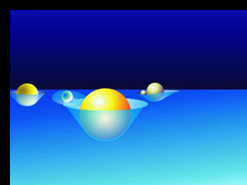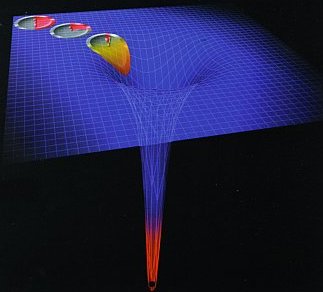Time Travel Research Center © 2005 Cetin BAL - GSM:+90 05366063183 - Turkey/Denizli
Special
and General Relativity: A Very Brief Overview
Albert Einstein’s theory of special relativity addresses what happens when objects move much faster than speeds we normally encounter, specifically, at speeds near the speed of light. Its results challenge our everyday experiences: moving clocks run slower and moving lengths get shorter.
 What’s
mind-boggling is that special relativity takes into account point of
view. Observers moving at different speeds, or in physics talk,
observers in different reference frames, experience different results from a
common event. We don’t notice these differences because the effects are tiny
for the speeds we’re used to. Special relativity's effects only become
noticable if one's speed becomes a significant fraction of the speed of
light. It not only turns time into a fourth dimension alongside the three
dimensions of space, thus forming the term “spacetime”, it claims that
neither space nor time is the same for everyone.
What’s
mind-boggling is that special relativity takes into account point of
view. Observers moving at different speeds, or in physics talk,
observers in different reference frames, experience different results from a
common event. We don’t notice these differences because the effects are tiny
for the speeds we’re used to. Special relativity's effects only become
noticable if one's speed becomes a significant fraction of the speed of
light. It not only turns time into a fourth dimension alongside the three
dimensions of space, thus forming the term “spacetime”, it claims that
neither space nor time is the same for everyone.
In general relativity, spacetime is not just the stage upon which things happen: Spacetime becomes a participant in the dynamics of objects. In general relativity, spacetime is a dynamic entity that expands, contracts, and curves around matter. Extremely massive objects, like black holes, cause spacetime to curve more than lighter objects would. From these concepts stems the idea of a “fabric of spacetime”.
It's worth emphasizing that these weird and counterintuitive notions are solidly grounded in reality: General relativity's predictions are tested everyday by simple measurements. For example, without taking into account general relativity's prediction for the rate at which time slows as a function of altitude above the earth's surface, the Global Positioning System (GPS) would lose accuracy at the rate of several kilometers per day. So far, general relativity has been consistent with every measurement and test that we have been able to throw at it.
Gravitational Waves I: A
Basic Look
Gravitational waves are produced from the acceleration of massive objects. They are predicted by general relativity to be the oscillations of spacetime, propagating at the speed of light. Gravitational waves (GWs) are the ripple effects, so to speak, of objects in motion.
GWs act by changing the distance
between widely separated masses, or by changing the shapes of the objects
they pass through, as they stretch along one axis and squeeze along the
other. Yet while gravitational radiation is infinite in range, it only
weakly interacts with matter. This characteristic is both gravity’s blessing
and its curse: gravitational waves can propagate large distances with
essentially zero absorption or distortion, but this exact property makes
them extremely difficult to detect.
Gravitational Waves II:
Slightly More In Depth
On paper, gravitational waves are described as a tensor perturbation to the metric of spacetime. At lowest order, GWs come from the time-changing quadrupole moment of mass and energy. (Monopole waves would violate mass-energy conservation and dipole waves would violate momentum conservation.) The quadrupole formula reveals that gravitational waves are difficult to produce and that gravitational interactions are extremely weak. Therefore, the only objects massive and relativistic enough to generate detectable gravitational waves are astrophysical.

When a gravitational wave’s wavelength is much larger than the object it acts on (as in, acting on a detector), the forces that arise from the two GW polarizations act as shown. The polarizations are named “+” (plus) and “×” (cross) because of their orientations with respect to the axes. These two polarizations are part of what makes gravitational waves analogous to sound.
Uhren
ticken langsamer
(Zeitdilation)
 Würde man eine Uhr, die in regelmäßigen Abschnitten ein Lichtsignal
aussendet in Richtung Schwarzes Loch schicken, würde diese, durch die starke
Gravitation ein zunehmend in Richtung der Farbe rot verschobenes Licht
aussenden (Rotverschiebung).
Würde man eine Uhr, die in regelmäßigen Abschnitten ein Lichtsignal
aussendet in Richtung Schwarzes Loch schicken, würde diese, durch die starke
Gravitation ein zunehmend in Richtung der Farbe rot verschobenes Licht
aussenden (Rotverschiebung).
Die Rotverschiebung ist auch in der Astronomie ein Mittel um herauszufinden,
wie schnell sich Galaxien ausdehnen und in welche Richtung. Die
Rotverschiebung basiert auf dem so genannten Dopplereffekt , der aus
den Relativbewegungen von Sender und Empfänger resultiert.
Vergleich: Ein Polizeiwagen mit eingeschalteter Sirene fährt auf mich zu,
dies führt zu einer erhöhten wahrgenommenen Schallfrequenz oder der Wagen
fährt von mir weg, die Schallfrequenz wird kleiner.
Da die Uhr in regelmäßigen Zeitabständen, z.B. jede Sekunde, ein
Signal in Richtung Beobachter aussendet, und die Uhr im Einflussbereich des
Schwarzen Loches immer stärker zu diesem beschleunigt wird und die
Entfernung immer schneller zunimmt, werden die Zeitsignale in immer längeren
Perioden zu mir als Beobachter gesendet. Ich könnte sagen, die Zeit vergeht
langsamer für die Uhr. Irgendwann ist die Uhr so sehr in den Fängen des
Lochs, dass das Licht nicht mehr schafft zu entkommen, die
Fluchtgeschwindigkeit müsste größer als Lichtgeschwindigkeit werden und dies
ist unmöglich, die unmittelbare Folge ist Zeitstillstand. Die Zeitdilation
nimmt also mit zunehmender Gravitation zu.
H
içbir yazý/ resim izinsiz olarak kullanýlamaz!! Telif haklarý uyarýnca bu bir suçtur..! Tüm haklarý Çetin BAL' a aittir. Kaynak gösterilmek þartýyla siteden alýntý yapýlabilir.The Time Machine Project © 2005 Cetin BAL - GSM:+90 05366063183 -Turkiye/Denizli
Ana Sayfa / Ýndex / Ziyaretçi
Defteri / ![]() E-Mail / Kuantum Fiziði / Quantum Teleportation-2
E-Mail / Kuantum Fiziði / Quantum Teleportation-2
Time Travel Technology / Kuantum Teleportation / Duyuru / UFO Technology